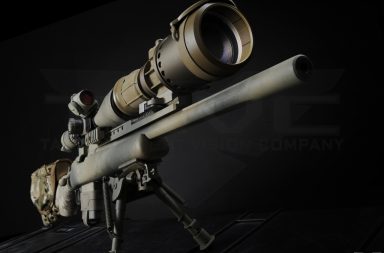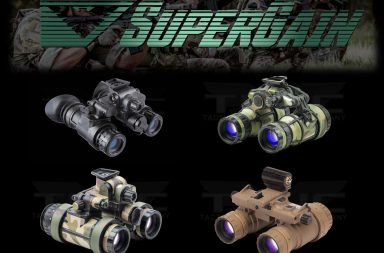A topic that interests a lot of you out there and we listend to that.
Today we have a guest post here from Richard Douglas who is a firearms expert and educator who breaks this question down for you and we hope you enjoy the read. If you have any questions, please drop them in the comments below.
~I recently had the opportunity to perform some night operations training over here in Texas with a group of friends.
And I have to admit:
Everytime I use night vision — whether wearing helmet-mounted goggles, using the best 6.5 Creedmoor scope with the aid of thermal, or engaging targets with a NV optic — I feel nearly invincible.
Afterall, seeing in the dark was only gifted to certain animals. Now, we have various night vision and thermal optics that allows us to see in the dark.
But which one should you choose? That’s exactly what I’m going to show you today. By the end of this guide, you’ll know if night vision or thermal optics is for you. Let’s dive right in!
Night Vision Scopes
During World War II, the U.S. snipers faced a problem:
They couldn’t see at night.
As a result, night operations were nearly impossible. That was until the military developed night vision scopes. These devices work by collecting any spec of light — including infrared light — and amplifying it to see in the dark.

This changed nighttime warfare forever — as we’ve seen in World War II, Vietnam War, Operation Desert Storm, and more.
Now, the technology has evolved beyond anyone’s wildest imagination, leading to several generations of highly sophisticated night-vision equipment. As a result, they’re widely used by gunners, aviators, and even hunters.
The question is: should you buy a night vision scope? To find out, let’s break it down:
Pros
- More affordable
- Wide Field of View (FOV)
- Durable
- Detailed image
Cons
- Can only function at night
- Dust, smoke, fog, and camouflage obscures the image
Best Use
If you’re on a budget and perform night-hunting in a clear open area, then get a night vision scope.

They’re cheaper (compared to thermal scopes), provide detailed images, works well in cold environments, and reliable.
Thermal Scopes
Unlike night vision, thermal optics read heat signatures.
As a result, you can now see warm-blooded animals (like hogs and deer) through tall grass, thick brushes, smoke, and fog.

But is it worth the extra money? Let’s figure out:
Pros
- Spot prey through tall grass, smoke, fog, bushes, sand, etc.
- Can be used in ANY lighting conditions — day and night
- Track footprints and handprints
- Doesn’t produce an image for others to see
Cons
- Expensive
- Larger (and Heavier)
- Requires training to interpret the image
- Can’t be used behind glass
- Poor image quality (compared to NV)
Best Use
Thermal scopes are best used for spotting hidden prey.

So if you’re a hunter that hunts in areas that has a lot of covers (like thick brushes and fog), then you’ll love thermal images. But keep in mind, thermal optics do cost a pretty penny — going well above the $2,000 price range!
Night Vision or Thermal Imaging?
One night, my brother and I were hunting some wild hogs over here in Texas.
I was using an AR-15 equipped with a night vision scope while my brother was using a thermal spotting scope.
We were hunting in a cornfield that had tall stubbles. After cruising for a while, my brother picked up something “hot” out there. It turns out, it was a BIG hog (weighing over 200 pounds).
The problem? I couldn’t see it with my night vision optic due to the stubbles. But, my brother had a clear sight of it with his thermal.
“Take the shot,” I told him. He placed the crosshairs on it and squeezed the trigger — BAM! The .300 Blackout pierced right behind its ear, causing the hog to fall dead flat.
The takeaway?
Thermal optics are excellent for target acquisition. That’s why hog hunters LOVE thermal imagers. No hog could hide from thermal.

On the contrary, night vision is great for target identification. That’s why Navy Seals rely on these devices when performing night operations.

To put it simply:
If your hunting area has a lot of clear space and natural light, then get night vision. However, if the field has a lot of bushes, stubbles and fog where prey can hide, thermal would be the best bet.
Personally, I like how easy it is to spot animals with thermal, but I also like the image of night vision. That said, there’s a way to get…
The Best of Both Worlds
I’ve got great news:
Thermal imaging just got affordable. You can buy yourself a handheld thermal monocular capable of detecting heat signatures out to 300 yards for less than $700.
The best part?
You can use it WITH your night vision scope. For example, you can take out a handheld thermal monocular to help locate prey, then use a night vision optic when you’re ready to shoot. That way, you get the best of both worlds — capable of spotting hidden prey and night vision for clear images.
However, thermal monoculars have less magnification, lower software technology, and no way of mounting it to guns. That’s why some prefer thermal riflescopes. But again, the primary purpose of a monocular is to spot prey — not take them down.
And that’s all there is to night vision vs. thermal. With what you’ve just learned so far…
What Night Vision Device Will You Choose?
Maybe a thermal riflescope or a night vision scope? Either way, let me know in the comments below.
Author Bio:
Richard Douglas is a firearms expert and educator. His work has appeared on large publications like The National Interest, Daily Caller, ODU Magazine, American Shooting Journal, SOFREP, and more. In his free time, he reviews various optics on his Scopes Field blog.



